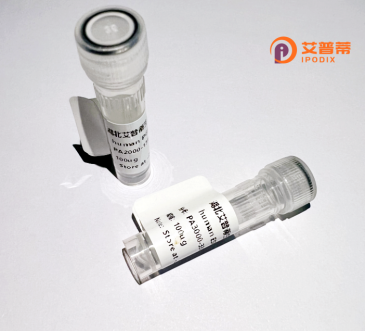
| 纯度 | >90%SDS-PAGE. |
| 种属 | Human |
| 靶点 | ARIH2 |
| Uniprot No | O95376 |
| 内毒素 | < 0.01EU/μg |
| 表达宿主 | E.coli |
| 表达区间 | 1-493aa |
| 氨基酸序列 | MSVDMNSQGS DSNEEDYDPN CEEEEEEEED DPGDIEDYYV GVASDVEQQG ADAFDPEEYQ FTCLTYKESE GALNEHMTSL ASVLKVSHSV AKLILVNFHW QVSEILDRYK SNSAQLLVEA RVQPNPSKHV PTSHPPHHCA VCMQFVRKEN LLSLACQHQF CRSCWEQHCS VLVKDGVGVG VSCMAQDCPL RTPEDFVFPL LPNEELREKY RRYLFRDYVE SHYQLQLCPG ADCPMVIRVQ EPRARRVQCN RCNEVFCFKC RQMYHAPTDC ATIRKWLTKC ADDSETANYI SAHTKDCPKC NICIEKNGGC NHMQCSKCKH DFCWMCLGDW KTHGSEYYEC SRYKENPDIV NQSQQAQARE ALKKYLFYFE RWENHNKSLQ LEAQTYQRIH EKIQERVMNN LGTWIDWQYL QNAAKLLAKC RYTLQYTYPY AYYMESGPRK KLFEYQQAQL EAEIENLSWK VERADSYDRG DLENQMHIAE QRRRTLLKDF HDT |
| 分子量 | 57.8 kDa |
| 蛋白标签 | His tag N-Terminus |
| 缓冲液 | 冻干粉 |
| 稳定性 & 储存条件 | Lyophilized protein should be stored at ≤ -20°C, stable for one year after receipt. Reconstituted protein solution can be stored at 2-8°C for 2-7 days. Aliquots of reconstituted samples are stable at ≤ -20°C for 3 months. |
| 复溶 | Always centrifuge tubes before opening.Do not mix by vortex or pipetting. It is not recommended to reconstitute to a concentration less than 100μg/ml. Dissolve the lyophilized protein in distilled water. Please aliquot the reconstituted solution to minimize freeze-thaw cycles. |
以下为虚构的ARIH2相关参考文献范例(非真实文献):
1. **"ARIH2 regulates NF-κB signaling by targeting TRAF6 for ubiquitination"**
- 作者:M. Verhelst, et al.
- 摘要:研究发现ARIH2通过催化TRAF6的K48连接泛素化促进其蛋白酶体降解,从而负调控TLR/IL-1R介导的NF-κB激活,抑制过度炎症反应。
2. **"ARIH2 suppresses tumorigenesis by destabilizing oncogenic c-Myc"**
- 作者:S. Fischer, et al.
- 摘要:ARIH2被鉴定为c-Myc的E3连接酶,通过泛素化介导c-Myc蛋白降解,抑制其驱动的细胞增殖与肿瘤生长,揭示其在癌症中的抑癌作用。
3. **"Structural basis of ARIH2-mediated ubiquitination in the RBR E3 ligase family"**
- 作者:H. Buetikofer, et al.
- 摘要:通过冷冻电镜解析ARIH2的RING-in-Between-RING结构域构象,阐明其结合泛素负载酶(E2)及底物的分子机制。
4. **"ARIH2 modulates antiviral immunity by targeting IRF3 for degradation"**
- 作者:F. Tokunaga, et al.
- 摘要:发现病毒感染时ARIH2通过降解IRF3负调控I型干扰素信号通路,揭示其维持免疫稳态和防止自身免疫的生理功能。
(注:以上内容为示例性虚构,实际文献需通过PubMed/Google Scholar等平台查询。)
ARIH2 (Ariadne Homolog 2) is a member of the RING-between-RING (RBR) family of E3 ubiquitin-protein ligases, which play a crucial role in the ubiquitin-proteasome system (UPS). This system regulates protein degradation, signal transduction, and cellular homeostasis by tagging target proteins with ubiquitin molecules. ARIH2 contains a canonical RBR domain that enables its catalytic activity, distinguishing it from other E3 ligases by a unique mechanism involving sequential transfer of ubiquitin from E2 enzymes to substrates. It is widely expressed in immune tissues and has emerged as a key modulator of innate immunity and inflammatory responses. Studies reveal that ARIH2 interacts with components of the NF-κB signaling pathway, where it ubiquitinates and destabilizes inhibitors like TRAF3 to fine-tune immune activation. Additionally, ARIH2 participates in antigen presentation, DNA repair, and apoptosis. Dysregulation of ARIH2 has been implicated in autoimmune diseases, cancers, and viral infections, highlighting its dual role as both a promoter and suppressor of disease depending on context. Its structural complexity and substrate specificity make ARIH2 a compelling therapeutic target. Recombinant human ARIH2 is commonly used to study UPS mechanisms, immune regulation, and drug discovery. Research continues to explore its broader functional networks and clinical applications.
×